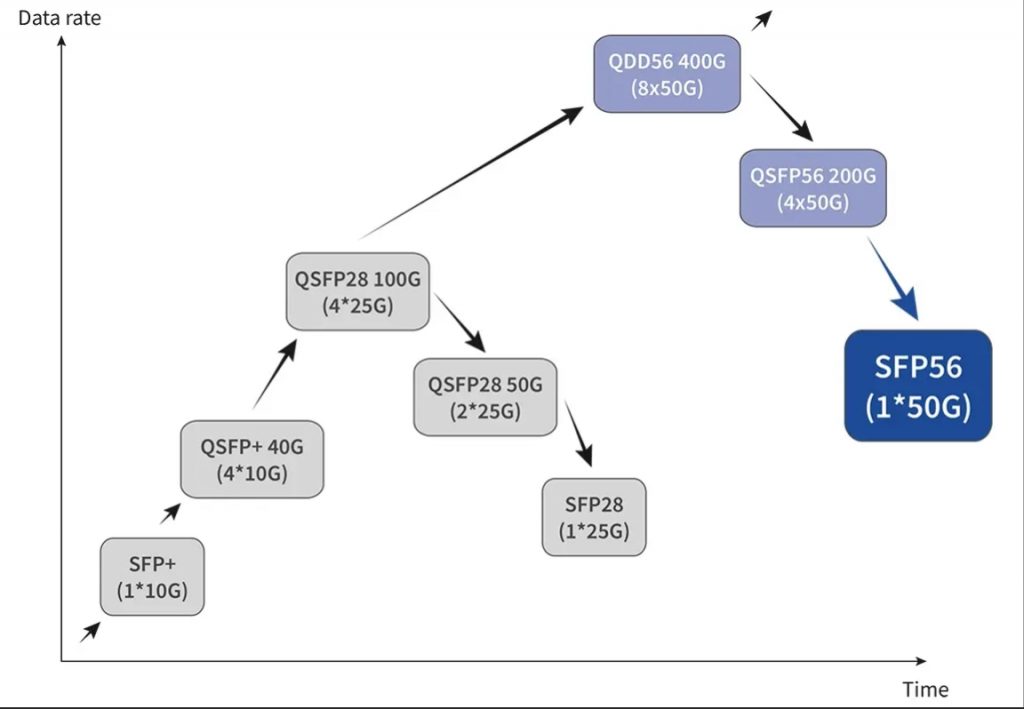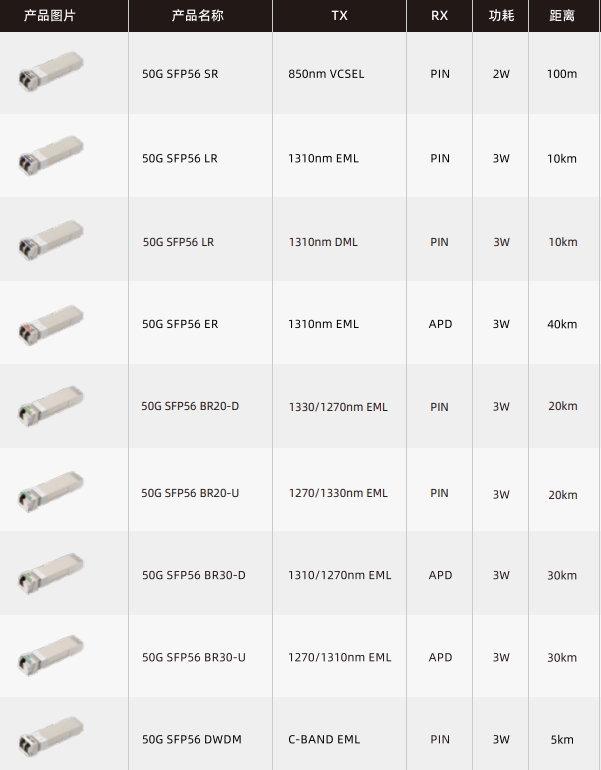In the modern era, telecommunications technology has progressed with a relentless pursuit of faster data transmission speeds. The relentless demand for heightened connectivity and swift data exchange has driven the evolution of transceivers to new heights. The quest for faster data rates encompasses not only the adoption of cutting-edge technologies but also the revitalization of older, previously overlooked technologies.
Years ago, optical transceiver manufacturers revolutionized the industry with the introduction of the SFP form factor, which boasted a compact size that significantly increased port density on telecommunication equipment. Today, this same physical footprint has been transformed into a powerful tool capable of achieving a staggering 50G data rate. This transformation is attributed to the innovative PAM4 technology and the enhanced form factor known as SFP56, representing a modern twist on a classic design that continues to push the boundaries of high-speed data transmission.
Understanding the Basics of 50G Technology:
As the telecommunications landscape advances, with discussions of 200G, 400G, 800G, and even higher data rates filling the air, one might wonder why 50G technology is just now gaining prominence. The relentless demand for bandwidth has propelled the industry to strive for ever-higher data rates, leading to the rapid adoption of multilane transceivers. However, as these technologies mature, the industry begins to explore the potential of single-lane transceivers, offering a new frontier in data transmission.
Engineers are constantly on the lookout for cost-effective solutions that cater to the needs of network designers and service providers. With multilane modules already proving their mettle, the industry is now embracing the emergence of a 50G single-lane transceiver that boasts a more compact design, lower cost, and reduced power consumption. This innovation represents a significant step forward in optimizing network infrastructure and enhancing overall performance.

The 50G SFP56 transceiver presents an exciting opportunity to double the data rate of existing SFP28 links, revolutionizing network performance. Its optimized construction ensures minimal insertion loss and crosstalk, enhancing signal integrity and reliability. Importantly, this solution maintains backward compatibility with existing SFP+ and SFP28 ports, simplifying upgrades and ensuring seamless integration within existing network infrastructures.
The primary applications for these groundbreaking products encompass server-to-switch and switch-to-switch 50G Ethernet connections, empowering data centers and enterprise networks with unparalleled speed and efficiency. Furthermore, they pave the way for future-proofing networks in anticipation of emerging technologies such as 5G wireless applications, ensuring that your infrastructure is ready to harness the full potential of these groundbreaking advancements.
What is SFP56?
NRZ modules have been around for a while, but demand is still growing, and the development of PAM4 QSFP-DD modules has started and is leading the way in high-density data rates in a small form factor. The small form factor SFP uses new technology that was previously only used in high-density optical transceivers, the trick is to reduce the number of channels to better fit the old reliable SFP form factor. Unlike other optical transceivers that use PAM4 modulation technology on a few optical paths. SFP56 uses 25G NRZ current, using PAM4 modulation on a single wavelength to achieve 50G PAM4 modulated optical signals. A logical question is if this new technology has some similarity or interchangeability with the older SFP variants (SFP+/SFP28), in which case SFP56 modules are compatible with the older SFP ports, but for equipment to take full advantage of 50G data rates on PAM4, a special type of switch must be used. Thankfully, most modern build equipment already has 50G SerDes built into its ASIC. Backward compatibility is also possible, and you can easily use SFP+ or SFP28 modules in ports designed for 50G modules.
In short, you can call this technology a new technology used in the older SFP+ form factor. But in such a small size, it provides twice the data rate of the previously used SFP28 module, thus providing faster bandwidth for data centers and 5G base stations.
GIGALIGHT 50G SFP56 portfolio

Conclusion
The need for higher bandwidth has driven the industry toward faster data rates, leading to the evolution of multi-channel transceivers. However, our quest for 50G has given us a groundbreaking revelation – the potential of single-channel, single-wavelength technology.
Engineers’ demand for cost-effective solutions has not only driven the performance of multi-channel modules, but is now also beginning to adopt more compact, economical and energy-efficient single-channel 50G versions. With its optimized structure and backward compatibility, the 50G SFP56 provides an opportunity to double the data rate of existing SFP28 links. Its application range extends to critical connections such as 50G Ethernet links from server to switch and switch to switch, as well as its role in shaping the future landscape of 5G wireless applications.
Finally, the journey from the introduction of the SFP form factor to the advanced SFP56 form factor – reinventing the industry’s promise of speed, efficiency, and pushing the boundaries of what’s possible. The 50G SFP56 and its technology promise to change the narrative of data transmission, providing a seamless bridge between new and legacy telecommunication technologies.
